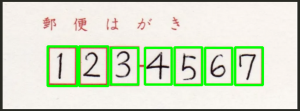元画像

scikit-learnの Handwritten Digits Data SetのSVMの学習済データから予想する。
import cv2
import matplotlib.pyplot as plt
def detect_zipno(fname):
img = cv2.imread(fname)
h, w = img.shape[:2]
img = img[0:h//6, w//3:]
gray = cv2.cvtColor(img, cv2.COLOR_BGR2GRAY)
gray = cv2.GaussianBlur(gray, (1, 1), 0)
im2 = cv2.threshold(gray, 140, 255, cv2.THRESH_BINARY_INV)[1]
cnts = cv2.findContours(im2, cv2.RETR_LIST, cv2.CHAIN_APPROX_SIMPLE)[0]
result = []
for pt in cnts:
x, y, w, h = cv2.boundingRect(pt)
if not(50 < w < 70): continue
result.append([x, y, w, h])
result = sorted(result, key=lambda x: x[0])
result2 = []
lastx = -100
for x, y, w, h in result:
if(x - lastx) < 10: continue
result2.append([x, y, w, h])
lastx = x
for x, y, w, h in result2:
cv2.rectangle(img, (x, y), (x+w, y+h), (0, 255, 0), 3)
return result2, img
if __name__ == '__main__':
cnts, img = detect_zipno("postcard.png")
cv2.cvtColor(img, cv2.COLOR_BGR2RGB)
cv2.imwrite("result.png", img)
$ python3 predict_zip.py
[9]
[2]
[5]
[4]
[3]
[4]
[8]
駄目だ、2と4しか合ってない
ただ、やり方の流れはわかった。
データセットの量を多くして、二次元配列を8x8ピクセルではなく、もう少し細かくしたら、結果が変わりそうだ。
